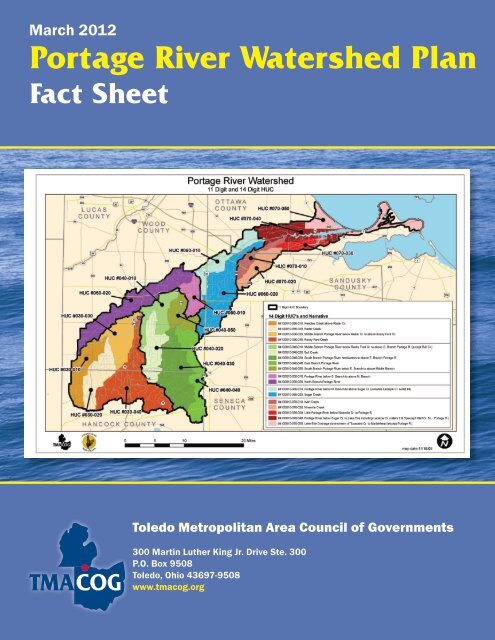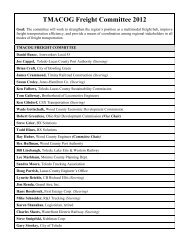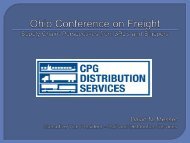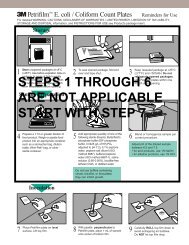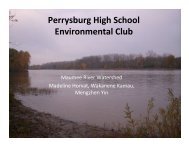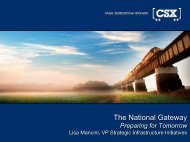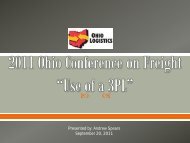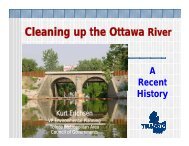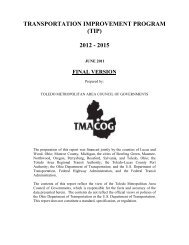Portage River Watershed Plan - Toledo Metropolitan Area Council of ...
Portage River Watershed Plan - Toledo Metropolitan Area Council of ...
Portage River Watershed Plan - Toledo Metropolitan Area Council of ...
Create successful ePaper yourself
Turn your PDF publications into a flip-book with our unique Google optimized e-Paper software.
March 2012<br />
<strong>Portage</strong> <strong>River</strong> <strong>Watershed</strong> <strong>Plan</strong><br />
Fact Sheet<br />
<strong>Toledo</strong> <strong>Metropolitan</strong> <strong>Area</strong> <strong>Council</strong> <strong>of</strong> Governments<br />
300 Martin Luther King Jr. Drive Ste. 300<br />
P.O. Box 9508<br />
<strong>Toledo</strong>, Ohio 43697-9508<br />
www.tmacog.org
<strong>Portage</strong> <strong>River</strong> <strong>Watershed</strong> <strong>Plan</strong><br />
Fact Sheet<br />
<strong>Portage</strong> <strong>River</strong> Overview<br />
The <strong>Portage</strong> is one <strong>of</strong> northwest Ohio’s principal rivers. It drains part <strong>of</strong> the Great Black Swamp,<br />
which includes some <strong>of</strong> Ohio’s most productive farmland, and is home to 67,000 residents. The<br />
watershed covers parts <strong>of</strong> Hancock, Ottawa, Sandusky, Seneca, and Wood counties, the cities <strong>of</strong><br />
Bowling Green, Fostoria, and Port Clinton, and 25 villages. Three communities — McComb,<br />
North Baltimore, and Fostoria — draw their drinking water directly from the river or a tributary,<br />
and many others use its groundwater. The <strong>Portage</strong> provides water supply and water drainage,<br />
plus recreation for its residents and visitors.<br />
The mainstem <strong>of</strong> the river is over 60 miles long, and has several major tributaries: the North,<br />
Middle, South, and East Branches, Needles Creek, Rader Creek, Rocky Ford, Sugar Creek, Wolf<br />
Creek, and the Little <strong>Portage</strong>. The river flows generally northeasterly and enters Lake Erie at<br />
Port Clinton, with a total watershed area <strong>of</strong> 581 square miles.<br />
The <strong>Portage</strong> <strong>River</strong> Basin <strong>Council</strong><br />
In 1994 the <strong>Portage</strong> <strong>River</strong> Basin <strong>Council</strong> was created within TMACOG to preserve and restore<br />
the integrity <strong>of</strong> all waterways in the <strong>Portage</strong> <strong>River</strong> watershed. In that time, watershed<br />
stakeholders and TMACOG have worked together to address sewage treatment issues, repair<br />
malfunctioning septic systems, provide grant funding for agricultural conservation, and test<br />
water quality to teach students ecology.<br />
<strong>Portage</strong> <strong>River</strong> Water Quality<br />
In 2011 Ohio EPA completed the <strong>Portage</strong> <strong>River</strong> <strong>Watershed</strong> TMDL Report. The TMDL (total<br />
maximum daily load) specifies how much pollution must be reduced from various sources in<br />
order to meet Ohio’s water quality standards. The standards are based on uses <strong>of</strong> the waterway<br />
— for instance, recreation, drinking, or to support aquatic life. Measurement <strong>of</strong> water quality<br />
includes testing for bacteria, chemical content <strong>of</strong> the water, and the diversity <strong>of</strong> species living in<br />
a stream. A stream that meets water quality standards for recreation, drinking, or aquatic life is<br />
said to be “in attainment.” Where a stream does not meet standards, the TMDL identifies the<br />
reasons by listing “causes and sources <strong>of</strong> impairment.”<br />
Impairments may include a wastewater plant that doesn’t meet treatment standards, failed<br />
septic systems, stormwater run<strong>of</strong>f from urban areas or feedlots, fertilizer run<strong>of</strong>f from suburban<br />
gardens or farm fields, or loss <strong>of</strong> natural habitat along streams.<br />
The TMDL found all watersheds in attainment for drinking water, but places three on a watch<br />
list for nitrates. Of 49 sites tested for aquatic life, 27 (55%) were in attainment, 11 (22%) in<br />
partial attainment, and 11 (22%) in non‐attainment. Of 57 sites tested for recreation (i.e., fecal<br />
bacteria), 8 (14%) were in attainment and 49 (86%) were in non‐attainment. Three watersheds<br />
list fish tissue impairments (e.g., PCBs).<br />
<strong>Portage</strong> <strong>River</strong> <strong>Watershed</strong> <strong>Plan</strong> Fact Sheet 2
The TMDL tells us that parts <strong>of</strong> the <strong>Portage</strong> system have good water quality, especially larger<br />
streams <strong>of</strong> the Middle and South Branches, and Rocky Ford watersheds. The most widespread<br />
impairment is high fecal bacteria (E. coli) levels. Likely sources are failed septic systems or<br />
manure run<strong>of</strong>f. Municipal wastewater effluent, especially from combined sewer overflows, is<br />
another likely source. Common impairments for aquatic life are sedimentation, high levels <strong>of</strong><br />
nutrients (phosphorus and nitrogen), and lack <strong>of</strong> habitat.<br />
The <strong>Portage</strong> <strong>River</strong> and Lake Erie<br />
In recent years extensive blue‐green algae blooms have returned to Lake Erie. Algae raises<br />
water treatment costs, contributes toxins to the water, and discourages fishing, swimming, and<br />
tourism on the lake. While the algae blooms are not completely understood, it is clear that they<br />
are driven by high phosphorus levels. Nutrient loadings from the <strong>Portage</strong> and other Lake Erie<br />
streams are feeding the algae blooms. The <strong>Portage</strong> TMDL sets specific numerical targets for<br />
phosphorus load reductions needed for a clean Lake Erie. Phosphorus load reductions call for<br />
improvements <strong>of</strong> wastewater treatment plants, septic systems, manure management, and<br />
agricultural production through Best Management Practices.<br />
The <strong>Watershed</strong> <strong>Plan</strong><br />
From 2007 to 2011 TMACOG<br />
and <strong>Portage</strong> <strong>River</strong> Basin<br />
<strong>Council</strong> members prepared<br />
the <strong>Portage</strong> <strong>River</strong> <strong>Watershed</strong><br />
<strong>Plan</strong>. This plan provides a<br />
comprehensive inventory <strong>of</strong><br />
the physical, chemical, and<br />
biological health <strong>of</strong> the<br />
eighteen smaller watersheds<br />
<strong>of</strong> the river. The plan also<br />
recommends goals for 9 <strong>of</strong><br />
the 18 subwatersheds<br />
(referred to as “hydrological<br />
units” or HUCs). The goals<br />
are designed to achieve the<br />
phosphorus loading targets set by the TMDL, and are based on stakeholder input and target the<br />
areas having the greatest potential for restoration and protection.<br />
The <strong>Plan</strong> is being submitted to OEPA and ODNR with a request for their endorsement. A stateendorsed<br />
watershed plan supports, and in some cases is required for, state and federal grants.<br />
The following table summarizes the types <strong>of</strong> projects that the <strong>Portage</strong> <strong>River</strong> <strong>Watershed</strong> <strong>Plan</strong><br />
recommends. Specific projects are listed for the subwatersheds in Chapter 5 <strong>of</strong> the plan.<br />
<strong>Portage</strong> <strong>River</strong> <strong>Watershed</strong> <strong>Plan</strong> Fact Sheet 3
Water Quality<br />
Impairment<br />
High fecal bacteria (E. coli)<br />
levels<br />
Example Restoration Project<br />
Repair / replace malfunctioning or obsolete home sewage<br />
treatment systems (HSTS)<br />
Extend public sewers to eliminate HSTS<br />
Upgrade public sewerage systems<br />
Manure management practices to keep livestock run<strong>of</strong>f out <strong>of</strong><br />
streams<br />
Habitat alteration<br />
Sedimentation / siltation<br />
Protect and restore floodplains<br />
Agricultural buffer strips between a farm field and the stream<br />
Improve riparian habitat along streams<br />
Nutrient enrichment<br />
(nitrates, phosphates)<br />
Repair / replace malfunctioning or obsolete home sewage<br />
treatment systems (HSTS)<br />
Extend public sewers to eliminate HSTS<br />
Upgrade public sewerage systems<br />
Manure management practices to keep livestock run<strong>of</strong>f out <strong>of</strong><br />
streams<br />
Agricultural buffer strips between a farm field and the stream<br />
Improve riparian habitat along streams<br />
Cover crops for nutrient removal<br />
Controlled field drainage systems<br />
All<br />
Educational workshops and programs on best management<br />
practices for land owners, public <strong>of</strong>ficials, and stakeholders<br />
Implementation<br />
Implementation <strong>of</strong> projects related to public sewerage systems or household sewage treatment<br />
systems may be carried out under regulatory programs <strong>of</strong> county Health Departments or Ohio<br />
EPA. The <strong>Watershed</strong> <strong>Plan</strong> recommends that agricultural or habitat projects should be<br />
implemented on a voluntary basis with the willing support <strong>of</strong> the property owner. This plan<br />
supports financial incentives to carry out these projects.<br />
<strong>Portage</strong> <strong>River</strong> <strong>Watershed</strong> <strong>Plan</strong> Fact Sheet 4
Developing projects to carry out the plan will be the role <strong>of</strong> the <strong>Portage</strong> <strong>River</strong> Basin <strong>Council</strong>.<br />
Stakeholder involvement in the <strong>Council</strong> brings local resources that will make effective projects:<br />
ideas and local contacts, public outreach, data, and matching funds or in‐kind services for grant<br />
applications.<br />
Restoring water quality impairments in the <strong>Portage</strong> <strong>River</strong> watersheds will protect public health<br />
by reducing pathogens in the river, improve the river’s water quality, reduce nutrient loadings<br />
that result in toxic algae blooms in Lake Erie, protect the river’s natural beauty, and enhance<br />
recreation along the <strong>Portage</strong>.<br />
Resources<br />
Fact Sheet for the Ohio EPA <strong>Portage</strong> <strong>River</strong> <strong>Watershed</strong> TMDL<br />
http://www.epa.ohio.gov/portals/35/tmdl/<strong>Portage</strong>_FactSheet_Final.pdf<br />
TMACOG <strong>Portage</strong> <strong>River</strong> <strong>Watershed</strong> <strong>Plan</strong><br />
http://www.tmacog.org/Environment/<strong>Portage</strong>/2011/<strong>Portage</strong>_<strong>River</strong>_<strong>Watershed</strong>_<strong>Plan</strong>.pdf<br />
TMACOG <strong>Portage</strong> <strong>River</strong> <strong>Watershed</strong> <strong>Plan</strong> Appendices<br />
http://www.tmacog.org/Environment/<strong>Portage</strong>/2011/<strong>Portage</strong>_<strong>Watershed</strong>_<strong>Plan</strong>_Appendices.pdf<br />
Acknowledgements<br />
The <strong>Portage</strong> <strong>River</strong> <strong>Watershed</strong> <strong>Plan</strong> was prepared with the support and valuable assistance <strong>of</strong><br />
many state and federal agencies, local agencies <strong>of</strong> Hancock, Ottawa, Seneca, Sandusky, and<br />
Wood Counties, local jurisdictions, and watershed stakeholders. TMACOG is grateful for their<br />
contributions and dedication to environmental stewardship <strong>of</strong> the <strong>Portage</strong> <strong>River</strong>. The <strong>Portage</strong><br />
<strong>River</strong> <strong>Watershed</strong> <strong>Plan</strong> was funded by a grant from the Ohio Department <strong>of</strong> Natural Resources<br />
Division <strong>of</strong> Soil & Water Resources, and matching funds by members <strong>of</strong> TMACOG.<br />
<strong>Portage</strong> <strong>River</strong> <strong>Watershed</strong> <strong>Plan</strong> Fact Sheet 5


